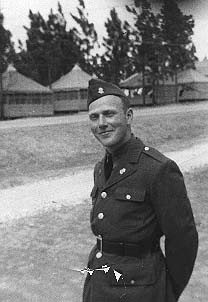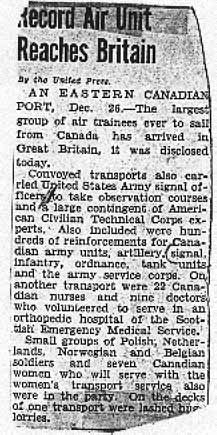|
This document contains the World War II
memories of Gardner L. Friedlander.
According to the July 1990
"Smithsonian" magazine, radar had been "in the
works" in Germany as early as 1933. Not long after that it
started being developed in England, France, Italy, Russia, and
the United States. Only England, however, really pushed radar
and its practical use. By the time the Nazis were ready to start
the blitz of England in July 1940, England had 29 radar stations
making an invisible curtain along its southern and eastern
coasts.
France fell to the Nazi blitzkrieg in June 1940,
the same week I graduated from Dartmouth. For two college summer
vacations I had worked in Chicago as a management trainee and
after graduating I was working there full time. A very low draft
number led to my enlisting in the army "one step ahead of
the sheriff" and let me join my brother and friends in the
32nd Division (National Guard). The 32nd had been called to
active service and was training at Camp Livingston, Louisiana.
It wasn't easy to quit
the job to start an unknown life, but after all, it was to be
for only one year(!). I joined about 100 other young men at the
Whitefish Bay armory for a final physical (which everyone prayed
he'd fail). We bussed to Camp Grant near Rockford, Illinois.
This was my home for a few weeks. I was sort of on permanent KP.
I never knew there were so many potatoes to peel, or so many
dirty pots, pans, and garbage pails to clean. Eventually, a
contingent of enlistees and draftees was sent to join the 32nd
Division, and I was on my way to "tent city in the
Louisiana swamp" as it was not too affectionately known.
I took basic training with the 127th Infantry. I was then
transferred to the 121st Field Artillery, where I served as a
radio operator in an antitank company, and was with brother Ted
during the summer maneuvers in Louisiana and Texas.
My part of the war games ended when I
was taken to the Camp Livingston hospital with a
severe case of poison ivy caught by sleeping in a
poison ivy patch. This was complicated by my being
placed in the measles ward where I caught that disease
as well as getting an infection in my left leg, which
the ward doctor said was to be amputated. Exciting!
Brother Ted got in touch with Dad, who pulled enough
strings to have the major medical powers at Camp
Livingston visit me at bedside. That ended talk of
amputation, and it wasn't long before I was 100% and
back on duty.
|
(Click for transcript.)
|

Maneuvers were
over, and after a month or so I got two weeks of
leave: Milwaukee!. On my return to camp in late
October 1941 I found that I had been
"battle field" promoted to 2nd
lieutenant, Signal Corps, 0-430118. I was posted
to Fort Monmouth, N.J., for a quick introduction
to the then new and very secret RADAR. It would
be the center of my life until 1945
|
Radar and its tactical use had been developed in
England by Sir Watson Watt, and was credited
with being the decisive factor in saving England
during the blitzes. Its usefulness was such a secret
that we were forbidden to mention it away from
wherever we were using it; forbidden to keep a diary
or to carry a camera; and when leaving school, were
given chemistry or astronomy books to carry to cloak
what we were studying.
| Fifty
of us with physics or electrical
engineering degrees were assembled at Ft.
Monmouth to be sent to England for
intensive radar training. We were supposed
to embark December 1st, 1941, but actually
didn't sail (from Halifax, Nova Scotia)
until December 10th (three days after
Pearl Harbor and the United States entry
into the war). We joined a British troop
ship convoy with some 25,000 United
Kingdom soldiers and other personnel, most
of whom were RAF fliers, gunners, and
mechanics who had been trained in Canada
and the USA. We had tremendous naval
protection. Our troop ship, perhaps one of
a dozen, was HMS "Potsdam." |
|
Life on board ship was not like pleasure
cruising. We were eight officers to a cabin
which in peace time would have been for two
passengers, with bunks four high. We were at
that in much more comfort than the enlisted
personnel sleeping four or six high in
hammocks. Food was O.K., served to all of us
the same, in mess kits. We would squat down
someplace to eat...on deck in good weather.
|

(Click for transcript.)
|
Life on board ship was not like pleasure
cruising. We were eight officers to a cabin which in
peace time would have been for two passengers, with
bunks four high. We were at that in much more
comfort than the enlisted personnel sleeping four or
six high in hammocks. Food was O.K., served to all
of us the same, in mess kits. We would squat down
someplace to eat...on deck in good weather.
|
For more information on these memoirs and
accompanying photos, please click on to Mr.
Friedlander's web
site.
| Editor's note: |
Gard originally wrote these memoirs in
1990 for his children and grandchildren; they
do not contain descriptions of the violence of the
war. The web version of Gard's memoirs was created
in April, 2000. |
|